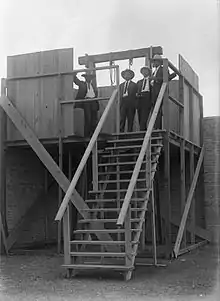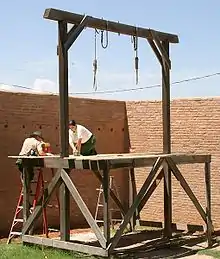Gallows
Gallows (or scaffold) are a frame, typically wooden, from which objects can be hung or "weighed". Gallows were thus widely used for public weighing scales for large objects such as sacks of grain or minerals, usually positioned in markets or toll gates. The term was also used for a framework from which a ship’s anchor might be raised so that it no longer sitting on the bottom, i.e., "weighing [the] anchor".

In modern usage it has come to mean almost exclusively a scaffold or gibbet used for execution by hanging.
Etymology
The term "gallows" was derived from a Proto-Germanic word galgô which refers to a "pole", "rod" or "tree branch". This points to the earlier execution style in which a person sentenced to death had been tied to a bent-down tree and then released.[1] With the beginning of Christianization, Ulfilas used the term galga in his Gothic Testament to refer to the cross of Christ, until the use of the Latin term (crux = cross) prevailed.[2]
Forms of hanging
Gallows can take several forms:
- The simplest form (as often used in the game "Hangman") resembles an inverted "L" (or a Greek/Cyrillic "Г"), with a single upright and a horizontal beam to which the rope noose would be attached.
- The horizontal crossbeam is supported at both ends.
- There were even temporary gallows, which were portable, but weaker.
- The Tyburn gallows, commonly known as Tyburn Tree, was triangular in plan, with three uprights and three crossbeams, allowing up to 24 people to be executed simultaneously when all three sides were used.
Occasionally, improvised gallows were used, usually by hanging the condemned from a tree or street light. Hangings from such improvised gallows are usually lynchings rather than judicial executions. In Afghanistan, the Taliban used football goals as gallows.
Types

Permanent
Gallows may be permanent to act as a deterrent and grim symbol of the power of high justice (the French word for gallows, potence, stems from the Latin word potentia, meaning "power"). Many old prints of European cities show such a permanent gallows erected on a prominent hill outside the walls, or more commonly near the castle or other seat of justice. In the modern era the gallows were often installed inside a prison; freestanding on a scaffold in the yard, erected at ground level over a pit, enclosed in a small shed of stone, brick or wood, built into the gallery of a prison wing (with the beam resting in brackets on opposite walls), or in a purpose-built execution suite of rooms within the wing.
Temporary
Gallows can also be temporary. In some of the cases, they were even moved to the location of the crime. In England, pirates were typically executed using a temporary gallows, at low tide in the intertidal zone, then left for the sea to wash over them during the following high tides.[3] John the Painter was hanged in 1777 from the mizzenmast of HMS Arethusa for arson in royal dockyards, the highest temporary gallows erected in British history.[4]

The only surviving New Drop gallows in the UK are in Rutland County Museum. The gallows were portable and were set up at the gaol (jail) when needed. These gallows were first used in 1813 to hang two burglars. The New Drop design was not very effective as the drop was too short to break the neck cleanly.
Portable
If a crime took place inside, gallows were sometimes erected—and the criminal hanged—at the front door. In some cases of multiple offenders it was not uncommon to erect multiple temporary gallows, with one noose per condemned criminal. In one case a condemned strangled to death in agony for forty minutes until he finally died from asphyxiation.
Horse and cart
Hanging people from early gallows sometimes involved fitting the noose around the person's neck while he or she was on a ladder or in a horse-drawn cart underneath. Removing the ladder or driving the cart away left the person dangling by the neck to slowly strangle. A noted example of this type of execution in the USA was the hanging of British spy John André in 1780.
Later, a "scaffold" with a trapdoor tended to be used, so victims dropped down and died quickly from a broken neck rather than through strangulation, especially if extra weights were fixed to their ankles.
During the era of public execution in London, England, a prominent gallows stood at Tyburn, on what is now Marble Arch. Later executions occurred outside Newgate Prison, where the Old Bailey now stands.
Examples
See also
References
- "Galgen, der". Digital dictionary of the German language (DWDS) (in German).
- Charles Archibald Anderson Scott (1885). Ulfilas, apostle of the Goths: together with an account of the Gothic churches and their decline. Cambridge: Macmillan and Bowes. p. 133.
- Konstam, Angus (1998). Pirates:1660–1730. Osprey Publishing. ISBN 1-85532-706-6.
- http://www.portsmouthdockyard.org.uk/Page%206.htm
External links
| Wikimedia Commons has media related to Gallows. |
- BBC Article about British manufacturer.
- wikibooks:A Researcher's Guide to Local History Terminology: Local History terminology.